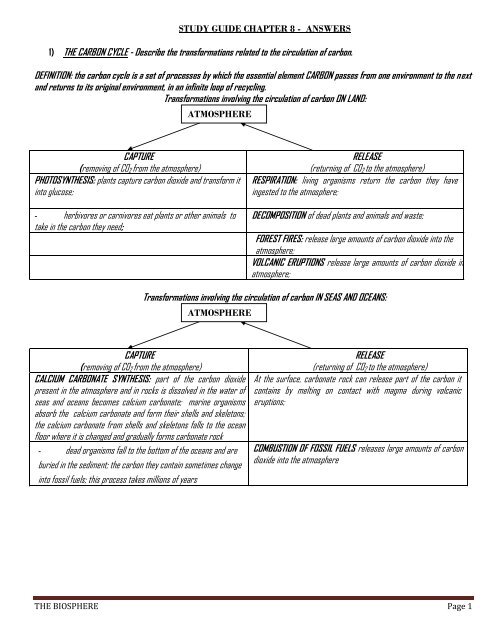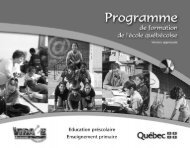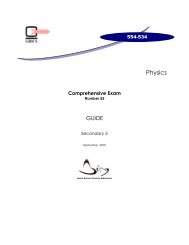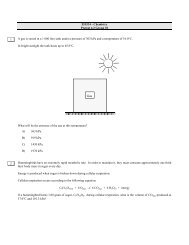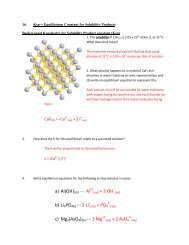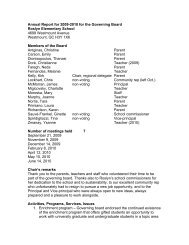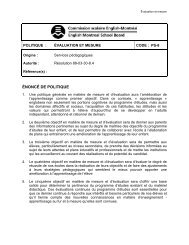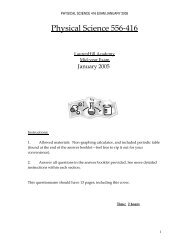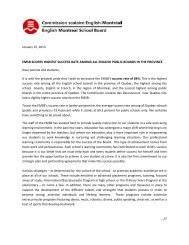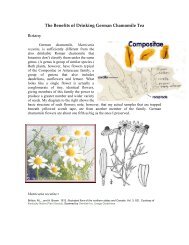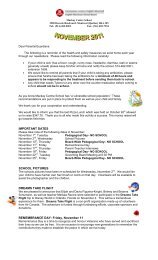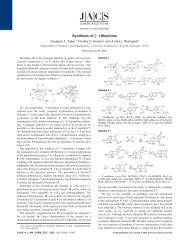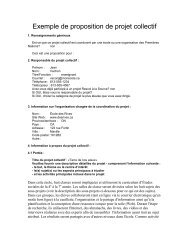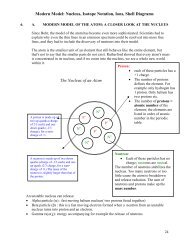STUDY GUIDE CHAPTER 8 - ANSWERS 1) THE CARBON CYCLE ...
STUDY GUIDE CHAPTER 8 - ANSWERS 1) THE CARBON CYCLE ...
STUDY GUIDE CHAPTER 8 - ANSWERS 1) THE CARBON CYCLE ...
Create successful ePaper yourself
Turn your PDF publications into a flip-book with our unique Google optimized e-Paper software.
<strong>STUDY</strong> <strong>GUIDE</strong> <strong>CHAPTER</strong> 8 - <strong>ANSWERS</strong><br />
1) <strong>THE</strong> <strong>CARBON</strong> <strong>CYCLE</strong> - Describe the transformations related to the circulation of carbon.<br />
DEFINITION: the carbon cycle is a set of processes by which the essential element <strong>CARBON</strong> passes from one environment to the next<br />
and returns to its original environment, in an infinite loop of recycling.<br />
Transformations involving the circulation of carbon ON LAND:<br />
ATMOSPHERE<br />
CAPTURE<br />
(removing of CO 2 from the atmosphere)<br />
PHOTOSYN<strong>THE</strong>SIS: plants capture carbon dioxide and transform it<br />
into glucose;<br />
- herbivores or carnivores eat plants or other animals to<br />
take in the carbon they need;<br />
RELEASE<br />
(returning of CO 2 to the atmosphere)<br />
RESPIRATION: living organisms return the carbon they have<br />
ingested to the atmosphere;<br />
DECOMPOSITION of dead plants and animals and waste;<br />
FOREST FIRES: release large amounts of carbon dioxide into the<br />
atmosphere;<br />
VOLCANIC ERUPTIONS release large amounts of carbon dioxide into the<br />
atmosphere;<br />
Transformations involving the circulation of carbon IN SEAS AND OCEANS:<br />
ATMOSPHERE<br />
CAPTURE<br />
(removing of CO 2 from the atmosphere)<br />
CALCIUM <strong>CARBON</strong>ATE SYN<strong>THE</strong>SIS: part of the carbon dioxide<br />
present in the atmosphere and in rocks is dissolved in the water of<br />
seas and oceans becomes calcium carbonate; marine organisms<br />
absorb the calcium carbonate and form their shells and skeletons;<br />
the calcium carbonate from shells and skeletons falls to the ocean<br />
floor where it is changed and gradually forms carbonate rock<br />
- dead organisms fall to the bottom of the oceans and are<br />
buried in the sediment; the carbon they contain sometimes change<br />
into fossil fuels; this process takes millions of years<br />
RELEASE<br />
(returning of CO 2 to the atmosphere)<br />
At the surface, carbonate rock can release part of the carbon it<br />
contains by melting on contact with magma during volcanic<br />
eruptions;<br />
COMBUSTION OF FOSSIL FUELS releases large amounts of carbon<br />
dioxide into the atmosphere<br />
<strong>THE</strong> BIOSPHERE Page 1
SAMPLE PROBLEMS<br />
2. List the processes of the carbon cycle that are illustrated in the photos below:<br />
Examples:<br />
CALCIUM <strong>CARBON</strong>ATE SYN<strong>THE</strong>SIS (<strong>THE</strong> MANUFACTURE OF CALCIUM <strong>CARBON</strong>ATE BY<br />
MARINE ORGANISMS LIKE SHELLS AND SKELETONS);<br />
PHOTOSYN<strong>THE</strong>SIS IN PLANTS;<br />
<strong>CARBON</strong> DIOXIDE (CO2) EMISSION BY CARS (FROM FOSSIL FUEL COMBUSTION);<br />
<strong>CARBON</strong> DIOXIDE (CO2) EMISSION BY A FOREST FIRE (COMBUSTION);<br />
<strong>CARBON</strong> DIOXIDE (CO2) EMISSION BY RESPIRATION IN PLANTS AND HUMANS;<br />
3. Carbon dioxide (CO2) is an important source of carbon for living organisms.<br />
a) Through which two processes does carbon enter the biosphere?<br />
PHOTOSYN<strong>THE</strong>SIS<br />
CALCIUM <strong>CARBON</strong>ATE SYN<strong>THE</strong>SIS (<strong>THE</strong> TRANSFORMATION OF CO2 DISSOLVED IN WATER<br />
INTO CALCIUM <strong>CARBON</strong>ATE -SHELLS AND SKELETONS OF MARINE ORGANISMS)<br />
b) The carbon absorbed by human beings usually ends up returning to the atmosphere as CO2. Briefly<br />
describe the two processes involved in this transfer.<br />
HUMAN BEINGS EXHALE CO2 IN <strong>THE</strong> PROCESS OF RESPIRATION. MEANWHILE, <strong>THE</strong><br />
DECOMPOSITION OF HUMAN WASTE AND REMAINS ALSO EMITS CO2 INTO <strong>THE</strong><br />
ATMOSPHERE.<br />
<strong>THE</strong> BIOSPHERE Page 2
2) DYNAMICS OF ECOSYSTEMS – BIODIVERSITY: Define the biodiversity of a community and explains factors that affect the<br />
biodiversity.<br />
DEFINITION: biodiversity describes the variety of species living in a community.<br />
FACTORS THAT AFFECT <strong>THE</strong> BIODIVERSITY:<br />
1) the number of species in the community(species richness);<br />
2) the relative abundance of each species( the number of individuals in a certain species in relation to the total number of individuals in<br />
the community (ex. the relative abundance of species A is 20%... meaning species A makes up 20% of the individuals in a community).<br />
SAMPLE PROBLEMS<br />
1. The Amazon Rainforest, in South America, is considered the most diverse forest habitat on Earth.<br />
What criteria do scientists use to establish the degree of biodiversity in a community?<br />
1) <strong>THE</strong> NUMBER OF SPECIES IN <strong>THE</strong> COMMUNITY (ITS SPECIES RICHNESS)<br />
2) <strong>THE</strong> RELATIVE ABUNDANCE OF EACH SPECIES IN <strong>THE</strong> COMMUNITY<br />
2. What is the relative abundance (as a percentage) of the species (underlined words) in<br />
question?<br />
1. in an aquarium, there are 16 fish, including 4 goldfish. 4÷16= 0.25 25%<br />
2. In a park there are 22 trees, including 6 pine trees. . 6÷22= 0.27 27%<br />
3. The picture below represents two different forests:<br />
a) Compare the species richness of the two forests:<br />
<strong>THE</strong>RE ARE FOUR SPECIES IN EACH FOREST. CONSEQUENTLY, <strong>THE</strong>IR SPECIES<br />
RICHNESS IS <strong>THE</strong> SAME.<br />
<strong>THE</strong> BIOSPHERE Page 3
) Find the relative abundance of each of the species in the two forests.<br />
Community 1 (20 trees)<br />
Community 2(20 trees)<br />
Species A . 5÷20= 0.25 25% Species A . 16÷20= 0.80 80%<br />
Species B. 5÷20= 0.25 25% Species B 1÷20= 0.05 5%<br />
Species C. 5÷20= 0.25 25% Species C 1÷20= 0.05 5%<br />
Species D. 5÷20= 0.25 25% Species D 2÷20= 0.1 10%<br />
C) Which forest has the greater biodiversity?<br />
COMMUNITY 1 BECAUSE <strong>THE</strong> RELATIVE ABUNDANCE OF EACH SPECIES IS SIMILAR.<br />
<strong>THE</strong> BIOSPHERE Page 4
4. TROPHIC RELATIONSHIPS: Describe the trophic levels (producers, consumers, decomposers). Explain the relationships<br />
between the trophic levels of a food web.<br />
TROPHIC RELATIONSHIPS: feeding connections among the living organism in an ecosystem.<br />
PRODUCERS: autotrophic organisms that have the ability to create organic matter from inorganic matter. They introduce the energy of<br />
the sun into ecosystems.<br />
CONSUMERS: heterotrophic organisms that feed on other living organisms.<br />
DECOMPOSERS: organisms that feed on the waste and remains os other living organisms; they recycle the matter in an ecosystem.They<br />
break down organic matter into inorganic matter, which then becomes available to producers.<br />
SAMPLE PROBLEMS<br />
1. What is the main source of energy in an ecosystem?_________________<br />
<strong>THE</strong> SUN<br />
2. A carnivore cannot be a primary consumer in a food chain. Explain your answer.<br />
BECAUSE PRIMARY CONSUMERS FEED ON PLANTS OR PARTS OF PLANTS.<br />
CARNIVORES FEED ON O<strong>THE</strong>R ANIMALS, NOT ON PLANTS, SO <strong>THE</strong>Y CANNOT BE<br />
PRIMARY CONSUMERS.<br />
3 Which trophic level do detritivores belong to? Explain your answer.<br />
DETRITIVORES BELONG TO <strong>THE</strong> TROPHIC LEVEL OF DECOMPOSERS BECAUSE <strong>THE</strong>Y<br />
FEED ON <strong>THE</strong> WASTE OF LIVING ORGANISMS AND ON DEAD MATTER.<br />
4. What is transferred from one organism to another within each ecosystem?<br />
MATTER AND ENERGY<br />
<strong>THE</strong> BIOSPHERE Page 5
6. Build a food chain based on the photos below:<br />
a) Draw the food chain.<br />
b) Specify the trophic level for each of the living organisms in your food chain.<br />
<strong>THE</strong> SUNFLOWER IS A PRODUCER. <strong>THE</strong> FLY, TROUT AND OTTER ARE ALL CONSUMERS.<br />
<strong>THE</strong> BIOSPHERE Page 6
7. Look at the illustration below.<br />
Raccoon<br />
Kingfisher<br />
Cattails<br />
Turtle<br />
Water lily<br />
Frog<br />
Perch<br />
Algae<br />
Detritivorous<br />
insects<br />
Bacteria<br />
Phytoplankton<br />
a) Among the organisms in the illustration, name those that are:<br />
a. PRODUCERS: CATTAILS, WATER LILY, ALGAE AND PHYTOPLANKTON<br />
b. CONSUMERS: RACCOON, KINGFISHER, FROG, TURTLE AND PERCH<br />
c. DECOMPOSERS: DETRITIVOROUS INSECTS AND BACTERIA<br />
b)Draw a possible food chain containing the organisms in the illustration.<br />
EXAMPLE: CATTAILS → TURTLE → RACCOON<br />
ALGAE →PERCH →KINGFISHER<br />
8. If you tried to establish the feeding relationships between all the organisms of the lake ecosystem<br />
illustrated in question 12, would you be drawing a food chain or a trophic network? Explain your<br />
answer.<br />
I WOULD BE DRAWING A TROPHIC NETWORK BECAUSE I WOULD BE REPRESENTING<br />
SEVERAL FOOD CHAINS IN <strong>THE</strong> SAME HABITAT.<br />
<strong>THE</strong> BIOSPHERE Page 7
9. The diagram below shows a simple food web:<br />
a) Which organism(s) are the producer(s)? <strong>THE</strong> VEGETATION<br />
b) Which organism(s) are primary consumer(s)? INSECTS, MOUSE, RABBIT, DEAR<br />
c) Which organism(s) are secondary consumer(s)? SNAKE, FOX, COUGAR<br />
d) Which organism(s) are tertiarty consumer(s)? <strong>THE</strong> FOX<br />
e) Which organism(s) are 4 th level consumers? <strong>THE</strong> COUGAR<br />
f) Which organism(s) are herbivores? INSECTS, MOUSE, RABBIT, DEAR<br />
g) Which organism(s) are omnivores? <strong>THE</strong> MICE<br />
h) Which organism(s) are carnivores? SNAKE, FOX, COUGAR<br />
<strong>THE</strong> BIOSPHERE Page 8
4) DISTURBANCES: Define a disturbance in a community. Explain the effects of certain factors that disturb the ecological balance.<br />
DEFINITION: a disturbance is an event that damages an ecosystem; any changes in an ecosystem affect its fauna and flora..<br />
A disturbance could: - lead to the disappearance of species<br />
- alter the availability of resources.<br />
TYPES OF DISTURBANCES<br />
NATURAL DISTURBANCES - they are triggered by environmental phenomena rather than by humans but they damage ecosystems<br />
nonetheless. Their effects can be felt even at the bottom of the ocean for example hurricanes, ice storms, sand storms, forest fire of natural<br />
origin etc.<br />
They vary in: - frequency (ex: the occasional springtime flooding of some rivers)<br />
- severity (ex: ice storms that can last a few hours or even several days)<br />
HUMAN DISTURBANCES - human activities that have a damaging effect on ecosystems. Produced by the constant increase in the expoitation<br />
of resources, these activities and their consequences disrupt the natural balance of ecosystems. For example logging operations, oil spills or<br />
mining.<br />
ECOLOGICAL SUCCESSION - After a disturbance, an ecosystem undergoes a series of changes that lead to the restoration of the natural<br />
balance the ecosystem that has been affected by a disturbance. Sometimes these changes are spread out over hundreds of years.<br />
SAMPLE PROBLEMS<br />
1. True or false? Explain your answers.<br />
a) The freezing of a lake can be considered a natural disturbance.<br />
TRUE. THIS DISTURBANCE IS NOT CAUSED BY HUMANS.<br />
b) Excessive hunting and fishing are human disturbances of ecosystems.<br />
TRUE. EXCESSIVE HUNTING AND FISHING CAN ALTER <strong>THE</strong> DYNAMICS OF AN<br />
ECOSYSTEM.<br />
c) All types of natural disturbance can occur in Québec.<br />
FALSE. SOME NATURAL DISTURBANCES, SUCH AS SANDSTORMS OR VOLCANIC<br />
ERUPTIONS, CANNOT OCCUR IN QUÉBEC.<br />
b) Ecological succession occurs only after a natural disturbance.<br />
FALSE. IT ALSO OCCURS AFTER A HUMAN DISTURBANCE.<br />
e) Transforming forests into farmland constitutes a natural disturbance.<br />
FALSE. IT IS A HUMAN DISTURBANCE.<br />
f) A flood following heavy rain is a natural disturbance.<br />
TRUE. THIS DISTURBANCE IS NOT CAUSED BY HUMANS.<br />
<strong>THE</strong> BIOSPHERE Page 9
g) A natural disturbance is always less serious that a human disturbance.<br />
FALSE. TSUNAMIS, EARTHQUAKES ARE VERY SERIOUS DISTURBANCESAND <strong>THE</strong>Y ARE NOT<br />
PRODUCED BY HUMAN ACTIVITY<br />
i) No ecosystem is immune to disturbances.<br />
TRUE. ALL ECOSYSTEMS ARE VULNERABLE TO DISTURBANCES.<br />
j) The current climate change has nothing to do with human disturbances.<br />
FALSE. <strong>THE</strong> INCREASE IN <strong>THE</strong> GREENHOUSE EFFECT THAT PRODUCED <strong>THE</strong> CURRENT<br />
CLIMATE CHANGE IS DUE TO <strong>THE</strong> COMBUSTION OF FOSSIL FUELS, WHICH IS A HUMAN<br />
ACTIVITY<br />
k) What is ecological succession?<br />
ECOLOGICAL SUCCESSION IS <strong>THE</strong> SERIES OF CHANGES THAT OCCUR IN AN<br />
ECOSYSTEM AFTER A DISTURBANCE WHICH CONTINUE UNTIL <strong>THE</strong> BALANCE OF<br />
<strong>THE</strong> ECOSYSTEM IS RESTORED.<br />
l) The current increase in the greenhouse effect is considered a human disturbance. List five effects that<br />
this disturbance has on the planet.<br />
CLIMATE CHANGE; INCREASE IN SEA LEVEL; ACID RAIN; INCREASE IN <strong>THE</strong><br />
FREQUENCY OF DROUGHTS; INCREASE IN <strong>THE</strong> FREQUENCY OF FLOODS;<br />
<strong>THE</strong> BIOSPHERE Page 10


